Principality of Waldeck and Pyrmont
The County of Waldeck (later the Principality of Waldeck and Principality of Waldeck and Pyrmont) was a state of the Holy Roman Empire and its successors from the late 12th century until 1929. In 1349 the county gained Imperial immediacy and in 1712 was raised to the rank of principality. After the dissolution of the Holy Roman Empire in 1806 it was a constituent state of its successors: the Confederation of the Rhine, the German Confederation, the North German Confederation, and the German Empire. After the abolition of the monarchy in 1918, the renamed Free State of Waldeck-Pyrmont became a component of the Weimar Republic until divided between Hannover and other Prussian provinces in 1929. It comprised territories in present-day Hesse and Lower Saxony (Germany).
Principality of Waldeck and Pyrmont Fürstentum Waldeck und Pyrmont | |||||||||||
|---|---|---|---|---|---|---|---|---|---|---|---|
| 1180–1918 | |||||||||||
 .svg.png.webp) Top: Flag
(before 1830) Bottom: Flag (after 1830) 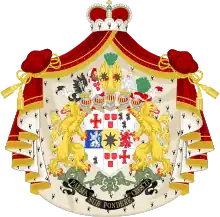 Coat of arms
| |||||||||||
| Anthem: "Mein Waldeck" | |||||||||||
.svg.png.webp) Waldeck (red) within the German Empire. The small northern territory is Pyrmont while the southern lands are Waldeck. | |||||||||||
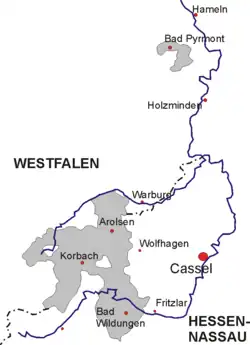 Map of Waldeck, showing the border between Westphalia and Hesse-Nassau | |||||||||||
| Status | State of the Holy Roman Empire State of the Confederation of the Rhine State of the German Confederation State of the North German Confederation State of the German Empire | ||||||||||
| Capital | Waldeck (to 1655) Arolsen (from 1655) 51°22′N 9°1′E | ||||||||||
| Common languages | German | ||||||||||
| Religion | United Protestant: Evangelical State Church of Waldeck and Pyrmont | ||||||||||
| Government | Principality | ||||||||||
| Prince | |||||||||||
• 1712–1728 | Friedrich Anton Ulrich (first) | ||||||||||
• 1893–1918 | Friedrich (last) | ||||||||||
| Historical era | Middle Ages | ||||||||||
• Established as a County | 1180 | ||||||||||
| 1349 | |||||||||||
• Succeeded to Pyrmont | 1625 | ||||||||||
| January 1712 | |||||||||||
• Administered by Prussia | 1868 | ||||||||||
| 1918 | |||||||||||
• Subsumed into Prussia | 1929 | ||||||||||
| Population | |||||||||||
• 1848 | 56,000[1] | ||||||||||
| |||||||||||
| Today part of | Germany | ||||||||||
History

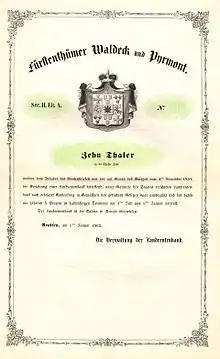
Waldeck was a county within the Holy Roman Empire from 1180. The ruling counts were a branch of the Counts of Schwalenberg (at Schwalenberg Castle). Waldeck Castle (Waldeck), overlooking the Eder river at Waldeck and first mentioned in 1120, was inherited by Count Widekind I of Schwalenberg and his son Volkwin, from the counts of Itter and the counts of Ziegenhain, when they married wives of these families. Waldeck remained the main residence of the county until 1655.
Its counts included Adolf II of Waldeck from 1270 to 1276. In 1655, the residence was shifted from Waldeck to Arolsen. In 1625, the small County of Pyrmont was added to Waldeck through inheritance, as it had also been ruled by a branch of the counts of Schwalenberg.
In January 1712, the count of Waldeck and Pyrmont was elevated to prince by Charles VI, Holy Roman Emperor. For a brief period, 1805 to 1812, Pyrmont was a separate principality as a result of inheritance and partition after the death of the previous prince, but the two parts were united again in 1812. The independence of the principality was confirmed in 1815 by the Congress of Vienna, and Waldeck and Pyrmont became a member of the German Confederation. From 1868 onward, the principality was administered by Prussia, but retained its legislative sovereignty. Prussian administration served to reduce administrative costs for the small state and was based on a ten-year contract that was repeatedly renewed for the duration of its existence. In 1871, the principality became a constituent state of the new German Empire. At the end of World War I, during the German Revolution that resulted in the fall of all the German monarchies, the prince was deposed and the principality became the Free State of Waldeck-Pyrmont within the Weimar Republic.
The princely house of Waldeck and Pyrmont is closely related to the royal family of the Netherlands. The last ruling prince, Frederick, was the brother of Queen Consort Emma of the Netherlands.
In 1905, Waldeck and Pyrmont had an area of 1121 km2 and a population of 59,000.
Military
Waldeck had raised a battalion of infantry in 1681 but for much of the subsequent history leading up to the Napoleonic Wars, Waldeckers generally served as what is commonly described as 'mercenaries', but was actually 'auxiliaries' hired out by the rulers of Waldeck for foreign service. Such was the demand that the single battalion became two in 1740 (the 1st Regiment), three battalions in 1744, four in 1767 (forming a 2nd Regiment). Most notably the foreign service was with the Dutch (the 1st and 2nd Regiments) and British (after an agreement was signed with Great Britain in 1776 to supply troops for the American War of Independence, the 3rd Waldeck Regiment, of a single battalion, was raised). The 3rd Waldeck Regiment thus served in America, where they were known under the 'umbrella term' used during that conflict for all Germans—'Hessians'. The regiment, which was made up of 4 'Battalion companies', a 'Grenadier' company, staff and a detachment of artillery, was captured by French and Spanish troops supporting the Americans and only a small number returned to Germany, where some formed part of a newly raised 5th Battalion (1784).
By the time of Napoleon's conquest of Germany, the Waldeck regiments in Dutch service had been dissolved when, as the Batavian Republic, the country was made into a kingdom ruled by Napoleon's brother Louis. Reduced to battalion strength, they now formed the 3rd battalions of the 1st and 2nd Infantry Regiments of the Kingdom of Holland. The 5th Battalion was disbanded, and Waldeck was now also obliged to provide two companies to the II Battalion, 6th German Confederation (i.e., Confederation of the Rhine) Regiment (along with two companies from Reuß) in the service of the French Empire. As with all French infantry, they were referred to as 'Fusiliers'. They served mainly in the Peninsular War against the Duke of Wellington. In 1812, the 6th Confederation Regiment was re-formed, with three companies from Waldeck and one from Reuß again forming the II Battalion. By the time of the downfall of the French Empire in 1814 the battalions in Dutch service had disappeared, but Waldeck now supplied three Infantry and one Jäger Companies to the newly formed German Confederation.

By 1866, the Waldeck contingent was styled Fürstlisches Waldecksches Füselier-Bataillon, and in the Austro-Prussian War of that year Waldeck (already in a military convention with Prussia from 1862) allied with the Prussians; however the battalion saw no action. Joining the North German Confederation after 1867, under Prussian leadership, the Waldeck Fusilier Battalion became the III (Fusilier) Battalion of the Prussian Infantry Regiment von Wittich (3rd Electoral Hessian) No. 83, and as such it remained until 1918. The position of regimental 'Chef' (an honorary title) was held by the Prince of Waldeck and Pyrmont.
Unlike Hesse-Darmstadt, Hesse-Kassel (or Hesse-Cassel) retained no distinctions to differentiate them from the Prussian. The Waldeckers however, were permitted the distinction of carrying the Cockade of Waldeck on the Pickelhaube. The Waldeck battalion was garrisoned, at various times, at Arolsen/Mengeringhausen/Helsen, Bad Wildungen, Bad Pyrmont and Warburg.
The regiment saw action in the Franco-Prussian War of 1870 (where it acquired the nickname Das Eiserne Regiment), and during the First World War—as part of the 22nd Division—fought mainly on the Eastern Front.
Gallery of castles
 Castle Waldeck, Hesse
Castle Waldeck, Hesse

 Friedrichstein Castle at Bad Wildungen
Friedrichstein Castle at Bad Wildungen

Rulers of Waldeck
Partitions of Waldeck under Waldeck rule
| County of Pyrmont (1189-1494) | ||||
| County of Schwalenberg (1220-1356) | ||||
| County of Waldeck (1107-1486) |
County of Sternberg (1255-1402) | |||
| County of Landau (1st creation) (1397-1495) |
||||
| Waldeck renamed County of Wildungen (1st creation, Waldeck line) (1486-1598) | ||||
| Inherited by the Spiegelberg family (1494-1557); the House of Lippe (1557-1583); and the Gleichen family (1583-1625) | ||||
| County of Landau (2nd creation) (1539-1579) |
||||
| County of Eisenberg (1475-1682) Raised to Principality of Eisenberg (1682-1692) |
County of Wildungen (2nd creation, Eisenberg line) (1607-1692) | |||
| County of Waldeck and Pyrmont (1692-1712) (Wildungen (Eisenberg) line) Raised to Principality of Waldeck and Pyrmont (1712-1918) |
County of Bergheim (1706-1918) | |||
Table of rulers
| Ruler | Born | Reign | Death | Ruling part | Consort | Notes | |
|---|---|---|---|---|---|---|---|
| Widekind I | ? | 1107-1137 | 11 June 1137 | County of Waldeck (at Schwalenberg until 1127) | Lutrud of Itter (d. bef. 2 March 1149) five children |
Brothers and first known ruling members of the family. | |
| Volkwin I | ? | 1107-1111 | c. 1111 | County of Waldeck (at Schwalenberg) | Unknown | ||
| Volkwin II | 1125 | 1137-1178 | 1178 | County of Waldeck | Luitgard of Reichenbach (d. aft. 1161) 1144 (annulled 1161) five children | Son of Widukind I. | |
| Henry I | c. 1170 | 1178-1214 | County of Waldeck | Heseke of Dassel (d. 25 July 1220) five children |
Sons of Volkwin II, divided the land, but was quickly reunited with Waldeck. | ||
| Herman I | 1163 | 1178-1225 | 1225 | County of Waldeck (at Schwalenberg) | Unmarried | ||
| Widekind II | 1148 | 1178-1189 | 1189 | County of Pyrmont | Unknown three children | ||
| Schwalenberg annexed to Waldeck | |||||||
| Gottschalk I | ? | 1189-1247 | 1247 | County of Pyrmont | Kunigunda of Limmer (d.1239) six children | ||
| Adolph I | c. 1190 | 1214-1270 | 3 October 1270 | County of Waldeck | Sophie (d.1254) two children Ethelind of Lippe (1204-1273) 14 February 1254 no children |
Children of Henry I, divided the land. | |
| Volkwin III | c. 1190 | 1214-1255 | c. 1255 | County of Schwalenberg | Ermengard of Schwarzburg-Blankenburg (d.22 March 1274) 14 February 1254 twelve children | ||
| Henry III[2] | 1225 | c. 1250-1267 | 1267 | County of Waldeck | Matilda of Cuyk-Arnsberg (1235-13 August 1298) four children | Co-ruled with his father Adolph I, but predeceased him. | |
| Gottschalk II | ? | 1247-1262 | 1258/62 | County of Pyrmont | Beatrice of Hallermund (d.1272) five children |
Children of Gottschalk I, ruled jointly. | |
| Herman I | ? | 1247-1265 | May 1265 | County of Pyrmont | Hedwig (d.20 June 1262) two children | ||
| Widekind I | ? | 1255-1264 | 28 September 1264 | County of Schwalenberg | Unknown c. 1246 Ermengard c. 1250 Unknown c. 1260 two children (in total) |
Elder children of Volkwin III, divided the land. Widekind didn't have children and his part was inherited by his younger brothers, while Henry I ruled independently at Sternberg and passed it to his own descendants. | |
| Henry I | ? | 1255-1279 | 1279 | County of Sternberg | ? of Woldenberg two children | ||
| Adolph | ? | 1264-1305 | 26 January 1305 | County of Schwalenberg | Adelaide (d.6 July 1274) Jutta (d.1 April 1305) |
Younger children of Volkwin III, ruled jointly. | |
| Albert | c. 1190 | 1264-1317 | After 5 February 1317 | County of Schwalenberg | Jutta of Rosdorf (d.aft.1 April 1305) 14 February 1254 twelve children | ||
| Herman II | ? | 1265-1328 | 25 November 1328 | County of Pyrmont | Luitgard of Waldeck- Schwalenberg (d.14 September 1317) five children |
Children of Gottschalk II and Herman I, ruled jointly. Herman III was a son of Herman I, and cousin of the other two rulers, sons of Gottschalk I. | |
| Gottschalk III | ? | 1265-1279 | 1279 | County of Pyrmont | Unmarried | ||
| Herman III | ? | c. 1265 | c. 1265 | County of Pyrmont | Unmarried | ||
| Adolph II | 1258 | 1270-1276 | 13 December 1302 | County of Waldeck | Unmarried | Abdicated in 1276 to his brother Otto, after a dispute with him and his other brothers on who would marry Sophia of Hesse, daughter of Henry I, Landgrave of Hesse, which Otto won, resulting in Adolph's resignation. Entering in clergy, Adolph eventually became Bishop of Liège (1301-1302). | |
| Otto I | 1262 | 1276-1305 | 11 November 1305 | County of Waldeck | Sophia of Hesse (1264-1340) 1276 nine children | Inherited the county as prize from his brothers after being chosen to marry Sophia of Hesse. | |
| Hoyer I | 1252 | 1279-1303 | 1303 | County of Sternberg | Agnes of Lippe (1251-aft.1307)five children | ||
| Henry II | ? | 1303-1318 | 8 January 1318 | County of Sternberg | Jutta of Tecklenburg (d.bef. 8 January 1318) five children | ||
| Henry IV | 1282 | 1305-1348 | 1 May 1348 | County of Waldeck | Adelaide of Cleves (d.1327) 1304 six children | ||
| Henry II[3] | ? | 1317-1349 | 11 April 1349 | County of Schwalenberg | Elisabeth of Wölpe (d. 2 February 1336) nine children Matilda of Rietberg (d.25 April 1400) 1342/45 one child | ||
| Henry III | ? | 1318-1346 | 1346 | County of Sternberg | Hediwg of Diepholz (d.aft.1335) bef.14 September 1330 four children |
Children of Hoyer II, ruled jointly. | |
| Hoyer II | ? | 1318-1320 | 1320 | County of Sternberg | Unmarried | ||
| Gottschalk IV | 1289 | 1328-1342 | 24 February 1342 | County of Pyrmont | Adelaide of Homburg (d.11 October 1341) six children |
Children of Herman II, ruled jointly. | |
| Henry I | ? | 1328-c. 1330 | c. 1330 | County of Pyrmont | Unmarried | ||
| Herman IV | 1310 | 1328-1334 | 1334 | County of Pyrmont | Unmarried | ||
| Henry II | ? | 1342-1390 | 1390 | County of Pyrmont | Unknown three children |
Children of Gottschalk IV, ruled jointly. | |
| Gottschalk V | ? | 1342-1355 | 1355 | County of Pyrmont | Unmarried | ||
| Herman V | ? | 1342-1360 | 1360 | County of Pyrmont | Oda (d.1360) no children/ three children | ||
| Herman VI | ? | 1342-1377 | 1377 | County of Pyrmont | Unmarried | ||
| Henry IV | ? | 1346-1385 | 1385 | County of Sternberg | Adelaide of Holstein-Pinneberg (c. 1330-bef. 21 May 1376) 1348 two children | ||
| Otto II | c. 1305 | 1348-1369 | 11 November 1369 | County of Waldeck | Matilda of Brunswick-Lüneburg (d.1355) 27 August 1339 two children Margaret of Löwenberg no children | ||
| Henry III | ? | 1349-1356 | After 19 December 1369 | County of Schwalenberg | Unmarried | Sold his estates to Waldeck in 1356, and pursued a religious life. | |
| Schwalenberg reabsorbed in Waldeck | |||||||
| Henry VI of Iron[4] | c. 1340 | 1369-1397 | 16 February 1397 | County of Waldeck | Elizabeth of Berg (c. 1340-4 October 1388) 16 December 1363 seven children | ||
| John | ? | 1385-1402 | 1402 | County of Sternberg | Unmarried | Left no heirs. The county was annexed to Waldeck. | |
| Sternberg annexed to Waldeck | |||||||
| Henry III | ? | 1390-1429 | 1429 | County of Pyrmont | Pelek two children Haseke of Spiegelberg (d.22 March 1465) two children | Son of Henry II (or according to other sources, son of Herman V). | |
| Henry VII[5] | c. 1370 | 1397-c. 1445 | After 1442 (c. 1445?) | County of Waldeck | Margaret of Nassau-Wiesbaden-Idstein (1380-aft.1435) 27 August 1398 three children |
Children of Henry VI, divided the land. | |
| Adolph III | 1362 | 1397-1431 | After 19 April 1431 | County of Landau | Agnes of Ziegenhain (d.aft.26 December 1438) 1387 one child | ||
| Henry IV | ? | 1429-1478 | 1478 | County of Pyrmont | Unmarried | Children of Gottschalk II, ruled jointly. | |
| Maurice | 1418 | 1429-1494 | 1494 | County of Pyrmont | Margaret of Nassau-Beilstein (d.27 December 1498) 1462 no children | ||
| Inherited by the Spiegelberg family (1494-1557), the House of Lippe (1557-1583) and the Gleichen family (1583-1625) Definitely annexed to Waldeck-Wildungen (from 1625) | |||||||
| Otto III | 1389 | 1431-1459 | 1459 | County of Landau | Anna of Oldenburg (d.aft.7 April 1438) 1424 three children | ||
| Wolrad I | 1399 | c. 1445-1475 | After 1 February 1475 | County of Waldeck | Barbara of Wertheim (1420-aft.1443) Bef.9 March 1440 three children | ||
| Otto IV | 1440 | 1459-1495 | 14 October 1495 | County of Landau | Matilda of Neuenahr (d.26 May 1465) 16 January 1464 one child Elisabeth of Tecklenburg (d.aft.1499) 1465 no children | ||
| Landau annexed by Eisenberg | |||||||
| Philip I | 1445 | 1475 | 1475 | County of Waldeck | Joanne of Nassau-Siegen 16 August 1452 or 14 October 1464 one child |
Children of Wolrad I. Philip I died months after his father. Philip II ruled at first as regent of his nephew, and then divided the land with him, in 1486. | |
| Philip II | 3 March 1453 | 1486-1524 | 16 October 1524 | County of Eisenberg | Catherine of Solms-Lich (1458-12 December 1492) 3 November 1478 six children Catherine of Querfurt (1450-22 February 1521) 1497 no children | ||
| Regency of Philip II, Count of Waldeck-Eisenberg (1475-1486) | |||||||
| Henry VIII[6] | 1465 | 1475-1513 | 28 May 1513 | County of Waldeck (1475–86) County of Wildungen (1486-1513) | Anastasia of Runkel (d.24 April 1503) Aft. 8 January 1492 three children | ||
| Philip IV[7] | 1493 | 1513-1574 | 30 November 1574 | County of Wildungen | Margaret of East Frisia (1500-15 July 1537) 17 February 1523 Emden nine children Catherine of Hatzfeld (d.1546) 1539 no children Jutta of Isenburg-Grenzau (d.28 July 1564) 6 October 1554 two children | ||
| Philip III the Elder | 9 December 1486 | 1524-1539 | 20 June 1539 | County of Eisenberg | Adelaide of Hoya (d.11 April 1513) 20 November 1503 Bad Wildungen four children Anna of Cleves (21 May 1495 – 24 May 1567) 22 January 1519 Kleve four children | ||
| Wolrad II the Scholar |  | 27 March 1509 | 1539-1575 | 15 April 1575 | County of Eisenberg | Anastasia Günthera of Schwarzburg-Blankenburg (31 March 1526 – 1 April 1570) 6 June 1546 Waldeck thirteen children |
Children of Philip III, divided the land, by mediation of Philip I, Landgrave of Hesse: the children from Philip III's first marriage, Wolrad and Otto, kept Waldeck, while the sons from the second marriage, John, Philip and Francis, inherited Landau. For the children who are usually said that did not reign (Otto, Philip and Francis), they are sometimes treated as Waldeck-Eisenberg (in the case of Otto) and Waldeck-Landau (cases of Philip V and Francis), which are the parts the called reigning brothers actually ruled, which may imply a level of co-regency between the brothers:
|
| Otto V | 1504 | 1539 | 8 March 1541 | County of Eisenberg | Unmarried | ||
| John I the Pious |  | 1521 | 1539-1567 | 9 April 1567 | County of Landau | Anna of Lippe (1529-24 November 1590) 1 October 1550 Detmold eight children | |
| Philip V the Deaf | 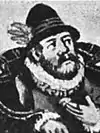 | 1519 | 1539-c. 1544? | 5 March 1584 | County of Landau | Elisabeth von Elsen (d. 12 June 1584) 27 June 1576 Hückeswagen no children | |
| Francis II[10] | 1526 | 1539-c. 1540? | 29 July 1574 | County of Landau | Maria Gogreve (d.1580) 1563 no children | ||
| Philip VI the Younger | 4 October 1551 | 1567-1579 | 9 November 1579 | County of Landau | Unmarried | Children of John I, ruled jointly. As neither of them left descendants, Landau was reabsorbed in Eisenberg. | |
| Francis III[11] | 27 June 1553 | 1567-1597 | 12 March 1597 | County of Landau | Unmarried | ||
| Landau was reabsorbed into Eisenberg | |||||||
| Daniel | 1 August 1530 | 1574-1577 | 7 June 1577 | County of Wildungen | Barbara of Hesse 11 November 1568 Kassel no children | Left no heirs, and was succeeded by his brother Henry. | |
| Josias I | 18 March 1554 | 1575-1588 | 6 August 1588 | County of Eisenberg | Maria of Barby-Mühlingen (8 April 1563 – 29 December 1619) 8 March 1582 four children |
Children of Wolrad II, ruled jointly. | |
| Wolrad III | 16 June 1563 | 1575-1587 | 12 November 1587 | County of Eisenberg | Unmarried | ||
| Henry IX[12] | 10 December 1531 | 1577 | 3 October 1577 | County of Wildungen | Anna of Viermund-Nordenbeck (1538-1599) 19 December 1563 Korbach no children | Died shortly after his brother, and didn't have children as well. | |
| Gunther | 19 June 1557 | 1577-1585 | 23 May 1585 | County of Wildungen | Margaret of Waldeck-Landau (1559-20 October 1580) 15 December 1578 Bad Wildungen no children Margaret of Gleichen (28 May 1556 – 14 January 1619) 20 May 1582 Gräfentonna one child | His second marriage brought the county of Bad Pyrmont back to Waldeck control. | |
| Regency of Margaret of Gleichen (1585-1598) | His death determined the extinction of the main branch of the House of Waldeck. | ||||||
| William Ernest | 8 June 1584 | 1585-1598 | 16 September 1598 | County of Wildungen | Umarried | ||
| Wildungen briefly annexed to Eisenberg | |||||||
| Wolrad IV | 7 June 1588 | 1588-1640 | 6 October 1640 | County of Eisenberg | Anna of Baden-Durlach (13 June 1587 – 11 March 1649) 8 September 1607 Durlach ten children |
Children of Josias I, divided the land. Christian took Wildungen for himself after its annexation in 1598. | |
| Christian | 25 December 1585 | 1607-1637 | 31 December 1637 | County of Wildungen | Elisabeth of Nassau-Siegen (8 November 1584 – 26 July 1661) 18 November 1604 Bad Wildungen fifteen children | ||
| Philip VII |  | 25 November 1613 | 1637-1645 | 24 February 1645 | County of Wildungen | Anna Catherine of Sayn-Wittgenstein (2 July 1610 – 1 December 1650) 26 October 1634 Frankfurt am Main six children | |
| Philip Theodore | .jpg.webp) | 2 November 1614 | 1640-1645 | 7 December 1645 | County of Eisenberg | Maria Magdalena of Nassau-Siegen (21 October 1622 – 30 August 1647) 25 August 1639 Culemborg two children | |
| Regency of George Frederick, Count of Waldeck-Eisenberg (1645-1659) | Left no heirs, and was succeeded by his uncle and previous regent. | ||||||
| Henry Wolrad | 28 March 1642 | 1645-1664 | 15 July 1664 | County of Eisenberg | Juliane Elisabeth of Waldeck-Wildungen (1637-1707) no children | ||
| Regencies of Anna Catherine of Sayn-Wittgenstein (1645-1660) and Henry Wolrad, Count of Waldeck-Eisenberg (1659-1660) | Children of Philip VII, ruled jointly. | ||||||
| Christian Louis | .jpg.webp) | 29 July 1635 | 1645-1706 | 12 December 1706 | County of Wildungen (1645–92) County of Waldeck and Pyrmont (1692-1706) | Anna Elisabeth of Rappoltstein (7 March 1644 – 6 December 1676) 2 July 1658 fifteen children Johanna of Nassau-Saarbrücken-Idstein (14 September 1657 – 14 March 1733) 6 June 1680 Idstein ten children | |
| Josias II | .jpg.webp) | 2 July 1636 | 1645-1669 | 8 August 1669 | County of Wildungen | Wilhelmine Christine of Nassau-Siegen (10 July 1629 – 22 January 1700) 26 January 1660 Arolsen seven children | |
| George Frederick |  | 31 January 1620 | 1664-1692 | 19 November 1692 | County of Eisenberg (1664–82) Principality of Eisenberg (1682–92) | Elisabeth Charlotte of Nassau-Siegen (11 March 1626 – 16 November 1694) 29 November 1643 Culemborg nine children | In 1682, he received the title of Prince. Left no surviving male heirs. The principality was inherited by Wildungen, which was kept as a county until a few years later. |
| Eisenberg (except Culemborg) was definitely annexed to Wildungen | |||||||
| Louise Anna | 18 April 1653 | 1692-1714 | 30 June 1714 | County of Eisenberg (at Culemborg) | George IV, Count of Erbach-Fürstenau 22 August 1671 Arolsen four children | Kept the lordship of Culemborg. As she survived all her children, the lordship was inherited, after her death, by her nephew, Ernest, Duke of Saxe-Hildburghausen. | |
| Culemborg was inherited by Saxe-Hildburghausen | |||||||
| Frederick Anton Ulrich |  | 26 November 1676 | 1706-1728 | 1 January 1728 | County of Waldeck and Pyrmont (1706–12) Principality of Waldeck and Pyrmont (1712–28) | Louise of Palatinate-Zweibrücken-Birkenfeld (28 October 1678 – 3 May 1753) 22 October 1700 Hanau eleven children |
Children of Christian Louis. Frederick Anton was elevated in 1712 to hereditary prince by Emperor Charles VI. On 30 September 1695, their father had changed the primogeniture house law of the Waldeck house, which he had enacted in 1685 and modified in 1687, insofar as he issued a paragium under the established suzerainty of the ruling line of the house, consisting of the three villages of Bergheim, Königshagen and Welle. This paragium, or vassal line, was inherited by Christian Louis' second son, Josias I. |
| Josias I | .jpg.webp) | 20 August 1696 | 1706-1763 | 2 February 1763 | County of Bergheim | Dorothea Sophia Wilhelmine zu Solms-Rödelheim and Assenheim (27 January 1698 – 6 February 1774) 17 January 1825 seven children | |
| Christian Philip | .jpg.webp) | 13 October 1701 | 1728 | 17 May 1728 | Waldeck and Pyrmont | Unmarried | Survived his father for a few months, and left no descendants. He was succeeded by his brother. |
| Charles August |  | 24 September 1704 | 1728-1763 | 29 August 1763 | Waldeck and Pyrmont | Christiane Henriette of Palatinate-Zweibrücken-Birkenfeld 19 August 1741 Zweibrücken seven children | |
| Frederick Charles August | 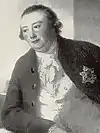 | 25 October 1743 | 1763-1812 | 24 September 1812 | Waldeck and Pyrmont | Unmarried | Left no heirs and was succeeded by his brother. |
| George | .jpg.webp) | 20 July 1732 | 1763-1771 | 9 April 1771 | County of Bergheim | Christine of Isenburg-Meerholz (22 November 1742 – 20 March 1808) 31 August 1766 no children | Left no heirs and was succeeded by his brother. |
| Josias II |  | 16 October 1733 | 1771-1788 | 4 January 1788 | County of Bergheim | Christine Wilhelmine of Isenburg-Büdingen (24 June 1756 – 13 November 1826) 5 March 1772 no children | |
| Josias III | .jpg.webp) | 13 May 1774 | 1788-1829 | 9 June 1829 | County of Bergheim | Wilhelmine of Löwenstein-Wertheim-Freudenberg (23 April 1774 – 25 June 1817) 10 January 1802 no children | Left no heirs and was succeeded by his brother. |
| George I |  | 6 May 1747 | 1812-1813 | 9 September 1813 | Waldeck and Pyrmont | Augusta of Schwarzburg-Sondershausen (1 February 1768 – 26 December 1849) 12 September 1784 Otterwisch three children | Brother of the previous. |
| George II | 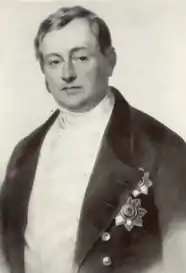 | 20 September 1789 | 1813-1845 | 15 May 1845 | Waldeck and Pyrmont | Emma of Anhalt-Bernburg-Schaumburg-Hoym 26 June 1823 Schaumburg five children | |
| Charles | .jpg.webp) | 17 November 1778 | 1829-1849 | 21 January 1849 | County of Bergheim | Karoline Schilling von Canstatt (2 February 1798 – 7 October 1866) 25 April 1819 six children | |
| Regency of Emma of Anhalt-Bernburg-Schaumburg-Hoym (1845-1858) | |||||||
| George Victor |  | 14 January 1831 | 1845-1893 | 12 May 1893 | Waldeck and Pyrmont | Helena of Nassau 26 September 1853 Wiesbaden seven children Louise of Schleswig-Holstein-Sonderburg-Glücksburg 29 April 1891 Luisenlund one child | |
| Adalbert I | 19 February 1833 | 1849-1893 | 24 July 1893 | County of Bergheim | Agnes Karolina of Sayn-Wittgenstein-Hohenstein (18 April 1834 – 18 February 1886) 3 August 1858 seven children Ida Charlotte of Sayn-Wittgenstein-Hohenstein (25 February 1837 – 7 May 1922) 18 October 1887 no children | ||
| Frederick | .jpg.webp) | 20 January 1865 | 1893-1918 | 26 May 1946 | Waldeck and Pyrmont | Bathildis of Schaumburg-Lippe 9 August 1895 Náchod four children | Brother of Queen Emma of the Netherlands. Abolition of the monarchy in 1918. |
| Adalbert II | 6 January 1863 | 1893-1918 | 23 February 1934 | County of Bergheim | Unmarried | Abolition of the monarchy in 1918. | |
See also
References
- A Pictorial Geography of the World: Comprising a System of Universal Geography, Popular and Scientific. Boston: C.D. Strong. 1848. p. 762.
- Numbered III because, despite being the second ruler named Henry, traditional genealogies numbered another Henry, son of Count Henry I, and a canon at Paderborn (1211-1288) as Henry II. This Henry II never ruled.
- This numbering taks in account Henry I, Count of Sternberg as Henry I of Schwalenberg
- Numbered VI because, despite being the fourth ruler named Henry, traditional genealogies numbered another Henry, son of Count Henry IV, and a dean at Minden (d.1349) as Henry V. This Henry V never ruled.
- Despite never missing any number from this point on, the numbering of the Henrys is irredeemably compromised (because of Henry II and Henry V, who never ruled). So, despite the total counting of 9 Henrys, only 7 actually ruled. Henry VII was the fifth ruler named Henry.
- Henry VIII was the sixth ruler named Henry.
- Despite succeeding first, he was numbered IV, probably because he was born after the then-still-heir Philip III of Eisenberg
- Haarmann (2014), p. 21.
- Wilhelm Blankertz Schloß Hückeswagen Sonderdruck einer Artikelserie des „Bergischer Volksbote" (Burscheider Zeitung) July 1940, PDF, retrieved 14 December 2014.
- Counted II because Francis I was a son of Count Philip II, and counted as I, despite never ruling, and that was bishop of Münster and Osnabrück (r.1532-1553)
- In fact the second Francis ruling.
- Henry IX was the seventh and final ruler named Henry.
External links
 Media related to Waldeck (state) at Wikimedia Commons
Media related to Waldeck (state) at Wikimedia Commons- Principality of Waldeck (in German)
- Canon law of the regnancy Waldeck, 1556
- Decorations of the Principality of Waldeck
- National anthem and flags
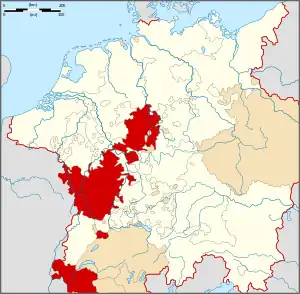
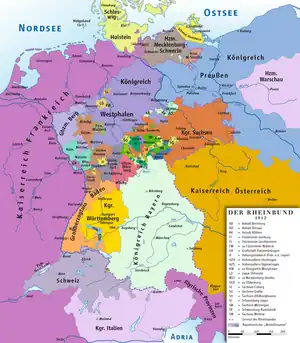
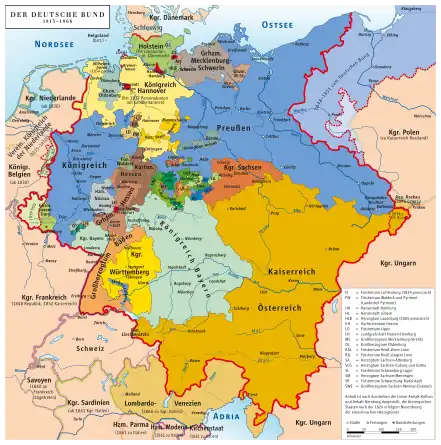
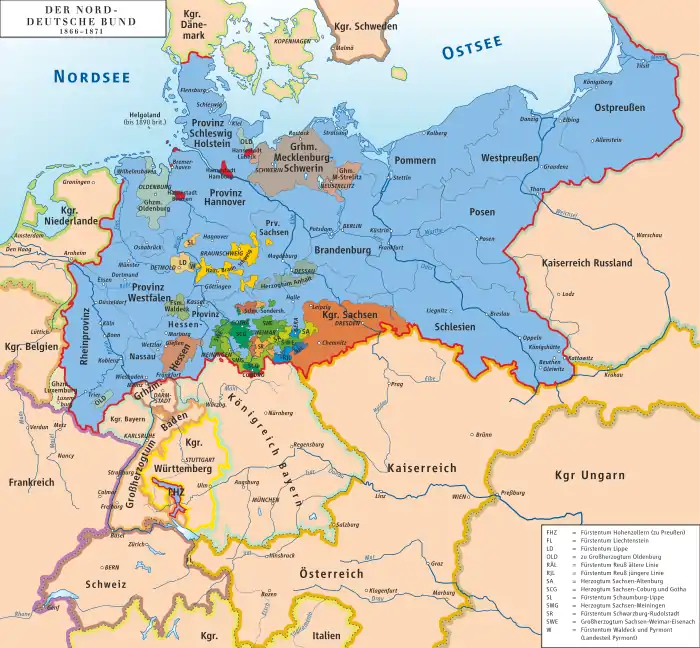
-en.png.webp)